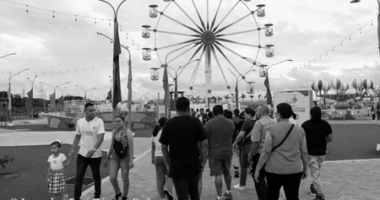
Priorizando a las personas
| Roger McKenzie
Estelí, la octava ciudad más grande de la nación centroamericana, capital de facto del Norte, es también la principal región productora de tabaco de Nicaragua. La tierra alrededor de Estelí es ideal para el cultivo de tabaco para puros y la ciudad se convirtió en un cónclave para tabaqueros cubanos que abandonaron la isla caribeña después de la revolución de 1959. Desde entonces, Estelí se ha convertido en una de las ciudades productoras de puros más importantes del mundo.
Los problemas de salud en Estelí que se derivan del tabaco para los trabajadores que lo producen y los fumadores que lo consumen, me pareció un buen lugar para conocer acerca del servicio de salud nicaragüense. Más tarde supe que, de hecho, la diabetes y la hipertensión actualmente son los principales problemas de salud en la zona.
Conseguí una entrevista exclusiva con el Dr. Mario Lazo Guerrero, director del sistema integral de salud del hospital local. El hospital de Estelí atiende una población urbana de más de 100.000 habitantes y, como gran parte de Nicaragua, a una comunidad rural considerable.
El Dr. Lazo me dijo que Nicaragua ha estado desarrollando un modelo de atención médica familiar y comunitaria gratuita, con énfasis en la prevención desde que los sandinistas regresaron al poder en 2007. Tiene una extensa red comunitaria que utiliza “brigadistas” voluntarios para llegar a las comunidades, especialmente en las zonas rurales.
Lazo y los miembros de su equipo reflejan el compromiso con la vocación de brindar atención médica de calidad que he visto en Gran Bretaña y otras partes del mundo, pero aquí se mezcla con el ferviente apoyo a la revolución nicaragüense.
Lazo dijo: “Los brigadistas desempeñan un papel central en la prestación de atención médica en Nicaragua. Se acercan a la comunidad y aseguran que no haya obstáculos para que las personas obtengan atención médica. Esto es realmente importante cuando, como en Nicaragua, la economía es principalmente rural. No siempre es fácil para las personas obtener lo que les corresponde”.
Como en la mayoría de las economías, ya sean capitalistas o revolucionarias, la forma en que las mujeres acceden a la atención médica es complicada. “Los brigadistas realmente son vitales para ayudarnos a mejorar la salud de las mujeres en Nicaragua”, me dijo Lazo. Esto se demuestra en la prioridad que los nicaragüenses dan a la reducción de las muertes neonatales. También es fundamental el apoyo a las mujeres durante el embarazo y los brigadistas desempeñan un papel importante en esta estrategia.
Lazo dijo: “Los brigadistas nos ayudan a identificar a las madres que no asisten al control prenatal. Pueden profundizar en la comunidad para identificar situaciones dónde las mujeres tienen problemas para conseguir transporte desde las zonas rurales a los centros de salud municipales. Los brigadistas nos alertan para que podamos tener las conversaciones necesarias para asegurarnos de que las mujeres obtengan el transporte que necesitan, cuando lo necesitan”.
Continuó diciendo: “Todos los médicos y enfermeras consultan con los brigadistas sobre problemas de salud en el sector bajo su responsabilidad. Esto nos da una alerta temprana de cualquier problema que pueda estar surgiendo a nivel muy local. Los brigadistas reciben capacitación para saber qué buscar, de modo que puedan consultar o alertar a personas médicamente capacitadas sobre lo que ven. Esto significa que normalmente podemos tener una respuesta rápida para hacer frente a cualquier situación grave que pueda surgir”.
Los brigadistas ayudan a los pacientes a través del sistema de salud y más de la mitad reciben teléfonos inteligentes para ayudarlos a comunicarse con los profesionales de la salud. “Tenemos reuniones periódicas sobre casos por Zoom, en las que participan brigadistas, por lo que son completamente parte del proceso”, me dijo Lazo.
Continuó: “Los brigadistas son parte del plan de parto de las mujeres embarazadas, particularmente las de riesgo. Ayudan a elaborar un plan para que las mujeres embarazadas puedan viajar hacia y desde el hospital. A diferencia de los años neoliberales, la mayoría de las mujeres dan a luz en hospitales. Actualmente, sólo el 0,2 por ciento de las mujeres dan a luz en casa”.
El nivel de atención a las mujeres embarazadas descrito por Lazo es asombroso y, en la Nicaragua revolucionaria, completamente gratuito. Explicó: “En Nicaragua, todas las mujeres son llevadas al hospital o a una casa de maternidad dos semanas antes de la fecha prevista para esperar el parto. Esto es completamente gratuito e incluye transporte, cama, comida y atención médica”.
Después del parto, las mujeres pueden permanecer en el hospital con sus hijos, “generalmente dos días después del parto antes de ser transportadas a casa”, dijo Lazo.
El cuidado no termina después del nacimiento del niño. Lazo explicó: “Los brigadistas nos ayudan a mantener el control sobre el programa de vacunación al que tiene derecho todo niño. Nos ayudan a asegurarnos de que el plan se mantenga porque es muy fácil creer que el trabajo termina después del nacimiento”.
Esta estrategia para reducir las muertes entre los recién nacidos está resultando un éxito. Lazo afirmó que “en esta zona en los primeros cinco meses de este año se han registrado mil 32 nacimientos, de los cuales 92 fueron prematuros. De este número hubo seis muertes, dos de los cuales fueron genéticamente malformados y no habrían sobrevivido”.
En Estelí hay alrededor de 1.322 brigadistas, “lo cual es fantástico, pero necesitamos más a medida que el grupo existente está envejeciendo. Estamos en un proceso constante de reclutamiento de nuevos brigadistas. A cada brigadista se le pide que identifique nuevas personas para eventualmente reemplazarlos”.
La pandemia del COVID en 2020 fue un desafío enorme para Nicaragua, como lo fue para el resto del mundo. Pero, para un país que intentaba construir un sistema de salud que no dependiera de cuánto dinero se tenía en el bolsillo, esto suponía un desafío adicional.
No hubo confinamientos durante la pandemia en Nicaragua. La economía permaneció abierta. No existía una política oficial de uso de mascarillas, salvo para las personas con afecciones respiratorias o las personas que atendían a los pacientes. En los hospitales y centros de salud, la mayoría de las personas usaban mascarillas y en todo el país había productos disponibles para lavarse las manos y desinfectantes con alcohol.
Nicaragua tuvo una de las tasas de mortalidad por 100.000 habitantes más bajas del mundo. La Organización Mundial de la Salud y la Universidad de Oxford reportaron una tasa de sólo 189, en comparación con 276 en el Reino Unido y 374 en Estados Unidos.
Se da por sentado que Estados Unidos y sus aliados y sus empleados en la prensa capitalista cuestionarán todo lo que digan las autoridades nicaragüenses, pero lo que no se puede negar es el papel fundamental desempeñado por los brigadistas al llegar a las comunidades para asegurarse de que todos recibieran la vacuna contra el COVID-19.
Cuando no viajas a Nicaragua para ver por ti mismo cómo la gente intenta construir su revolución, es fácil tomar la cómoda ruta de creer en informes de lo que mucha gente considera fuentes de noticias confiables.
Mi consejo es que vayas y veas por ti mismo lo que este increíble país está tratando de hacer para garantizar que todos tengan acceso a la atención médica, independientemente de su capacidad para pagarla. El cambio revolucionario lleva tiempo, pero seguramente una de las principales medidas es la prioridad que una nación otorga para que todos puedan obtener atención médica de la mejor calidad posible.
Nicaragua ciertamente pone a las personas en primer lugar y trata de involucrar a toda la población para brindar la mejor atención posible.
Los brigadistas desempeñan un papel central en el proceso.
*Roger McKenzie es un periodista del Reino Unido que ha pasado un tiempo en Nicaragua. Aquí informa sobre el modelo de atención médica familiar y comunitaria gratuita de Nicaragua y el papel de los “brigadistas” en la asistencia a mujeres embarazadas y poblaciones rurales. Habla con el Dr. Mario Lazo Guerrero, director de salud local en Estelí.
———————————————————-
Putting people first
Estelí, the eighth-largest city of the Central American nation, the de facto capital of the north, is also the country’s main tobacco production region. The land around Estelí is ideal for growing cigar tobacco and the city became a conclave for Cuban cigar makers who left the Caribbean Island after the revolution in 1959. Since that time Estelí has become one of the most important cigar producing cities anywhere in the world.
Tobacco and the health problems that arise from it for the workers who produce it and the smokers that use it seemed to me a good place to look at the Nicaraguan health service. I later learned that in fact diabetes and hypertension were currently the main health issues in the area.
I secured an exclusive interview with Dr Mario Lazo Guerrero, the director of the integral system of healthcare at the local hospital. The hospital in Estelí serves an urban population of more than 100,000 and, like much of Nicaragua, a sizeable rural community.
Dr Lazo told me that Nicaragua has been developing a free family and community model of healthcare with an emphasis on prevention since the Sandinistas returned to power in 2007. They have an extensive community network that makes use of volunteer “brigadistas” to reach out into the community, particularly the rural areas.
Lazo and the members of his team that I met mirrored the commitment to the vocation for providing quality healthcare that I have seen in Britain and other parts of the world, but here it was mixed with the fervent support for the Nicaraguan revolution.
Lazo said, “The brigadistas play a central role in the delivery of healthcare in Nicaragua. They reach out into the community and make sure that there are no obstacles to anyone getting healthcare. This is really important when, like Nicaragua, your economy is mainly rural. It is not always easy for people to get what they are entitled to.”
As in most economies, whether capitalist or revolutionary, how women access healthcare is complicated. “The brigadistas are really vital for us in helping us to improve women’s health in Nicaragua,” Lazo told me. This is demonstrated through the priority given by the Nicaraguans to reducing neonatal deaths. The Nicaraguans place a high priority on supporting women through pregnancy and the brigadistas play a major role in this strategy.
Lazo said, “The brigadistas help us to identify mothers not attending pre-natal care. They can dig deep into the community to identify things like where women have problems with getting transport into the municipal health centers from the rural areas. The brigadistas alert us so we can have the necessary conversations to make sure that women get the transport they need, when they need it.”
He went on to say, “Doctors and nurses all consult with brigadistas over health concerns in the sector they are responsible for. This gives us early warning of any problems that might be arising at a very local level. Brigadistas get trained to know what to look for so that they can consult with or alert medically trained people on what they see. This means we can usually have a speedy response to deal with anything serious that might come up.”
Brigadistas help support patients through the healthcare system and more than half are given smartphones to help them to communicate with healthcare professionals. “We have regular Zoom case meetings, which involve brigadistas, so they are completely part of the process,” Lazo told me.
He continued, “Brigadistas are part of the birthing plan of pregnant women, particularly of those at risk. They help develop a plan to get pregnant women to and from hospital. Unlike in the neoliberal years, most women give birth in hospitals. Only 0.2 per cent of women now give birth at home.”
The level of care for pregnant women described by Lazo is astonishing and, in revolutionary Nicaragua, completely free. He explained, “In Nicaragua all women are brought into hospital or a maternity home two weeks before their due date to await birth. This is completely free for all their transportation, bed, food and healthcare.”
After the birth women can stay in hospital with their children, “for usually two days after the birth before being transported home,” Lazo said.
The care doesn’t end after the birth of the child. Lazo explained, “The brigadistas help us to maintain control over the vaccination programme that every child is entitled to. They help us to make sure that the plan is maintained because it’s all too easy to believe that the job is done after the birth.”
This strategy for reducing deaths among newborns is proving to be a success. Lazo stated that, “In this area in the first five months of this year there have been 1,032 births, of which 92 were premature. Of this number there were six deaths of which two were genetically malformed and would not have survived.”
In Estelí there are around 1,322 brigadistas, “which is great but we need more as the existing cohort is getting old. We are in a constant process of recruiting new brigadistas. Each brigadista is asked to identify new people to eventually replace them.”
The 2020 Covid pandemic was a massive challenge for Nicaragua, as it was for the rest of the world. But, for a country trying to build a healthcare system that did not depend on how much money you had in your pocket, this was an additional challenge.
There were no lockdowns during the pandemic in Nicaragua. The economy remained open. There was no official mask wearing policy, save for people with respiratory conditions or people providing care to patients. In hospitals and healthcare centers most people wore masks and handwashing and alcohol hand sanitizers were available throughout the country.
Nicaragua had one of the lowest death rates per 100,000 population in the world. The World Health Organization and Oxford University both reported a rate of just 189, compared with 276 for the UK and 374 for the US.
It’s taken for granted that the US and their allies and their employees in the capitalist press will dispute whatever the Nicaraguan authorities say, but what can’t be denied is the critical role played by the brigadistas in reaching out into the community to make sure everyone received the COVID vaccine.
When you don’t travel to Nicaragua and see for yourself how people are attempting to construct their revolution, it’s easy to take the comfortable route of believing reports from what many people consider to be reputable news sources.
My advice is to go and see for yourself what this amazing country is trying to do to make sure that everyone has access to healthcare regardless of their ability to afford it.
Revolutionary change takes time, but surely one of the main measures is the priority that a nation places on everyone being able to get the best possible quality of healthcare.
Nicaragua certainly puts people first and tries to involve the whole population in providing the best possible care.
The brigadistas play a central part in the process.




